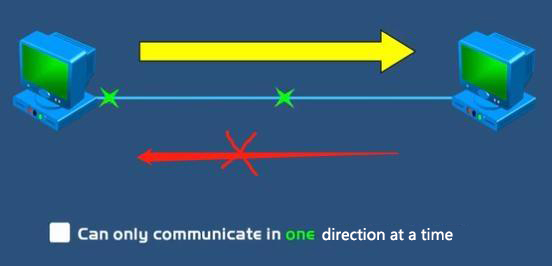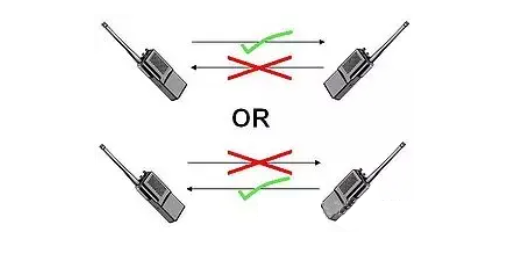

 Knowledge Base +
Knowledge Base +  2024.01.30
2024.01.30Concepts Simplex: Data transmission supports data transfer in only one direction.

Duplex: Between two communication devices, bidirectional data transfer is allowed. Typically, there are two duplex modes: half-duplex and full-duplex.
Full-Duplex A full-duplex system permits simultaneous bidirectional data transmission between two devices. Common telephones and mobile phones are examples of full-duplex systems, as they allow both speaking and listening at the same time.

Half-Duplex A half-duplex system permits bidirectional data transmission between two devices but not simultaneously. Therefore, only one device is allowed to transmit data at a time, and the other device must wait until the transmitting device finishes before processing.

Comparison of Full-Duplex and Half-Duplex
The half-duplex transmission mode employs carrier-sense multiple access/collision detection. Traditional shared LANs operate in half-duplex mode, making transmission conflicts common on the line. Nodes connected to hubs (where multiple nodes share a connection to a switch port) must operate in half-duplex mode, as they need collision detection.
The full-duplex transmission mode can be used for point-to-point Ethernet connections and fast Ethernet connections without encountering conflicts, as they utilize separate wire pairs in twisted pair cables.
Typically, the network card's duplex type can be modified in the advanced properties of the network card, usually set to auto-negotiation. Switches have Duplex lights; if they are lit, it indicates that they are operating in full-duplex mode. The majority of switches can automatically recognize and support duplex mode without manual configuration.
Simulation of Full-Duplex Systems
When a device connects to a network, it needs to utilize a channel access method to enable the transmission and reception of data over the same physical medium. The channel access method used in this scenario is referred to as duplexing, which includes the following two methods: Time Division Duplexing (TDD)
Time Division Duplexing (TDD), abbreviated as TDD, utilizes time division multiplexing technology to separate the transmission and reception of signals. It employs a half-duplex transmission to simulate the process of full-duplex transmission.
Drawbacks:
In TDD systems, it is necessary to add guard bands in adjacent sections, which can decrease spectral efficiency. Otherwise, a synchronization mechanism is required to synchronize the transmission of one device with the reception of another device. The synchronization mechanism increases system complexity and costs, and because all devices and time blocks need to be synchronized, it also reduces the flexibility of bandwidth usage.
TDD has significant advantages in asymmetric networks (networks with unequal upload and download bandwidths).
It can dynamically adjust the bandwidth according to the amount of data being uploaded and downloaded. If the amount of data being uploaded is large, the upload bandwidth will be increased, and if the data volume decreases, the bandwidth will be reduced.
Another advantage of TDD is that in slow-moving systems, the wireless paths for uploading and downloading are roughly the same, allowing technologies like beamforming to be used in TDD systems.
Examples of TDD systems:
UMTS/WCDMA TDD mode (indoor use) TD-SCDMA system DECT IEEE 802.16 WiMAX TDD mode
Packet networks using carrier-sense multiple access/collision detection technology, such as Ethernet networks or Ethernet networks using hubs, wireless LANs, and Bluetooth, although not using fixed frame widths like TDMA, can all be considered TDD systems.
Frequency Division Duplexing (FDD)
Frequency Division Duplexing (FDD) separates the transmission and reception of signals using frequency division multiplexing technology.
Drawbacks:
In this scenario, TDD wastes some bandwidth when switching between transmission and reception, resulting in longer latency and more complex and power-consuming circuits.
Advantages of FDD:
It is simpler and more efficient in radio frequency planning because devices transmit and receive using different frequency bands, ensuring that devices do not receive their own transmitted data, and the transmitted and received data do not affect each other.
The sections between uploading and downloading are separated by "frequency offset."
If the amount of data being uploaded and downloaded is similar, FDD is more efficient than TDD.
Examples of FDD systems:
Asymmetric digital subscriber lines and ultra-high-speed digital subscriber loops Most mobile phone systems, including UMTS/WCDMA FDD mode IEEE 802.16 WiMAX FDD mode
Additional Learning Hub Resources
What is the difference between OM5, OM3 and OM4?
What are the advantages of OM5 fiber optic patch cords
Subscribe to the newsletter
for all the latest updates.
2-5# Building, Tongfuyu Industrial Zone, Aiqun Road, Shiyan Street, Baoan District, Shenzhen. China
